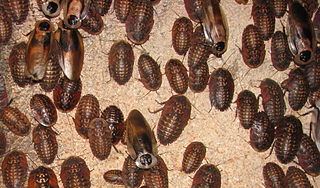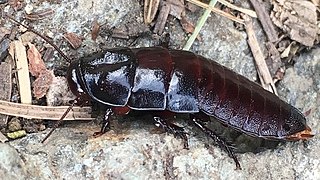
Termites are a group of detritophagous eusocial insects which consume a wide variety of decaying plant material, generally in the form of wood, leaf litter, and soil humus. They are distinguished by their moniliform antennae and the soft-bodied and often unpigmented worker caste for which they have been commonly termed "white ants"; however, they are not ants, to which they are distantly related. About 2,972 extant species are currently described, 2,105 of which are members of the family Termitidae.

Bufo is a genus of true toads in the amphibian family Bufonidae. As traditionally defined, it was a wastebasket genus containing a large number of toads from much of the world but following taxonomic reviews most of these have been moved to other genera, leaving only seventeen extant species from Europe, northern Africa and Asia in this genus, including the well-known common toad. Some of the genera that contain species formerly placed in Bufo are Anaxyrus, Bufotes, Duttaphrynus, Epidalea and Rhinella.

In animals, viviparity is development of the embryo inside the body of the mother, with the maternal circulation providing for the metabolic needs of the embryo's development, until the mother gives birth to a fully or partially developed juvenile that is at least metabolically independent. This is opposed to oviparity, where the embryos develop independently outside the mother in eggs until they are developed enough to break out as hatchlings; and ovoviviparity, where the embryos are developed in eggs that remain carried inside the mother's body until the hatchlings emerge from the mother as juveniles, similar to a live birth.

Bookworm is a general name for any insect that is said to bore through books.

Dictyoptera is an insect superorder that includes two extant orders of polyneopterous insects: the order Blattodea and the order Mantodea (mantises). All modern Dictyoptera have short ovipositors and typically lay oothecae. The oldest fossils of Dictyoptera from the Late Carboniferous, referred to as "roachoids" have long ovipositors and did not lay oothecae. The oldest modern oothecae-laying dictyopterans date to the Late Triassic.

Giant cockroaches, or blaberids, are the second-largest cockroach family by number of species. Mostly distributed in warmer climates worldwide, this family is based on the American genus Blaberus, but much of the diversity is also found in Africa and Asia.

Blattidae is a cockroach family in the order Blattodea containing several of the most common household cockroaches. Notable species include:

Cryptocercus is a genus of Dictyoptera and the sole member of its own family Cryptocercidae. Species are known as wood roaches or brown-hooded cockroaches. These roaches are subsocial, their young requiring considerable parental interaction. They also share wood-digesting gut bacteria types with wood-eating termites, and are therefore seen as evidence of a close genetic relationship, that termites are essentially evolved from social cockroaches.

Blattodea is an order of insects that contains cockroaches and termites. Formerly, termites were considered a separate order, Isoptera, but genetic and molecular evidence suggests they evolved from within the cockroach lineage, cladistically making them cockroaches as well. The Blattodea and the mantis are now all considered part of the superorder Dictyoptera. Blattodea includes approximately 4,400 species of cockroach in almost 500 genera, and about 3,000 species of termite in around 300 genera.

Cockroaches are insects belonging to the order Blattodea (Blattaria). About 30 cockroach species out of 4,600 are associated with human habitats. Some species are well-known as pests.
Insect diuretic hormones are hormones that regulate water balance through diuretic action.

Mastotermes darwiniensis, common names giant northern termite and Darwin termite, is a termite species found only in northern Australia. It is the most primitive extant termite species. Contrary to common belief, this species does not form mounds as the nests are subterranean and inconspicuous. Colonies will readily occupy and infest decomposing wood but primarily live in a complex subterranean network of tunnels and galleries which they use to travel to new food sites. Colonies may eventually split and form isolated satellite colonies.

Blattellaquinone, also known as gentisyl quinone isovalerate, is a sex pheromone of the German cockroach. Blattellaquinone is secreted by females to attract male cockroaches.
Blattabacterium is a genus of obligate mutualistic endosymbiont bacteria that are believed to inhabit all species of cockroach studied to date, with the exception of the genus Nocticola. The genus' presence in the termite Mastotermes darwiniensis led to speculation, later confirmed, that termites and cockroaches are evolutionarily linked.

Haemopis sanguisuga is a species of freshwater leech in the family Haemopidae. It is commonly called the horse-leech, but that is due to the similarity of its appearance to the leech Limnatis nilotica, which sometimes enters the nasal cavities of livestock. Haemopis sanguisuga does not behave in this way. Another synonym for this leech is Aulastomum gulo.
Behavior-altering parasites are parasites with two or more hosts, capable of causing changes in the behavior of one of their hosts to enhance their transmission, sometimes directly affecting the hosts' decision-making and behavior control mechanisms. They do this by making the intermediate host, where they may reproduce asexually, more likely to be eaten by a predator at a higher trophic level which becomes the definitive host where the parasite reproduces sexually; the mechanism is therefore sometimes called parasite increased trophic facilitation or parasite increased trophic transmission. Examples can be found in bacteria, protozoa, viruses, and animals. Parasites may also alter the host behaviour to increase protection of the parasites or their offspring; the term bodyguard manipulation is used for such mechanisms.

Eublaberus distanti, known as the six-spotted, four-spotted, four-spot, or Trinidad bat-cave roach or cockroach, is a primarily cave-dwelling Central and South American cockroach of the genus Eublaberus and named after William Lucas Distant.
Thorax porcellana Saussure is a species of epilamprid cockroach occurring in Sri Lanka and India. Both sexes are fully winged, but only the male takes flight, and then rarely and on short flights.
Blabericolidae is a family of parasitic alveolates in the phylum Apicomplexia.

Diploptera punctata, the Pacific beetle cockroach, is a species of cockroach in the family Blaberidae and subfamily Diplopterinae. It is one of the few cockroach species that is viviparous. Adults are chemically defended, having a modified tracheal gland and spiracle on each side which squirts quinones which can poison or discourage a predator.















